Executive Summary
Climate alarmism is reaching new levels of urgency. Activists and political leaders say that governments have fewer than 10 years to save the planet, which they claim will become unlivable within our lifetimes because of increased emissions of dangerous pollution including greenhouse gases. Former President Joe Biden has argued that young voters are in despair and that their “whole generation is damned” because of climate change. As a result, it should be no surprise that some people might choose not to bring a child into a world that they see as rapidly eroding.
That despair does not remain abstract. It seeps into household decisions as marriage is postponed and children are deferred, and missing births in the early years are only partly made up later. A smaller rising generation means fewer future workers and caregivers and more pressure on already stretched safety nets. The humane response is to welcome children, remove policy barriers that make family life needlessly expensive, and tell the truth about the long-run environmental progress that has made people safer.
It is true that 2024 was the warmest year on record, but the premise that the world is becoming more dangerous for people is not supported by the data. The longer-run story for people is greater safety from climate-related hazards because development, early warning, and infrastructure dramatically reduce vulnerability. According to the International Disaster Database, climate-related deaths across the globe are on a steady downward trend and have fallen by more than 90 percent over the past century. In the U.S., strong tornadoes have fallen ~50% since the 1950s, and (when adjusted for how much has been built) normalized tornado damage has decreased. Wildfire severity on federal lands shows no clear long-term upward trend in the century-scale record; recent spikes are dominated by (sometimes intentional) human ignition and exposure patterns, not by a new climate regime.
Meanwhile, U.S. fertility hit a new low in 2024 and remains subdued in 2025. Many cite cost of living, housing, work–family trade-offs, partnership, and climate concerns as reasons not to have children or more children. A better course is pro-family, pro-innovation policy: Keep cleaning the environment through technology while lowering barriers to marriage and child-rearing. The environment is cleaner and safer for people than it was in the past, resources are more abundant, and feeding the world has never been easier. Much work remains, especially extending freedom and prosperity to underdeveloped regions, but terrifying young people with apocalyptic visions is inhumane and, on the facts, wrong.
U.S. air quality trends have been improving for decades; the globe continues to become greener; and, despite a quadrupling of the global population since 1928, deaths caused by natural disasters and extreme weather have gone down by more than 90 percent over the past hundred years. Those who are considering not having children because of perceived uneasiness about the state of the environment should evaluate the evidence on environmental quality and the human effects of climate alarmism. The anti-human environmentalist movement is incorrect, but alarmism may nevertheless be contributing to climate anxiety among young people.
Humanity’s progress is not at odds with a clean and safe environment. In the case of global development, including population growth and environmental stewardship, we can have our cake and eat it too.
Introduction
Today’s would-be parents may be wrestling with a peculiar moral dilemma. The more concerned they are about the environment, the more skeptical they are about the prospect of having children. Former President Joe Biden has argued that young voters are in despair and that their “whole generation is damned” by climate change.REF In the words of former Vice President Kamala Harris, this is what young people call climate anxiety: “the fear of the future and the unknown of whether it makes sense for you to even think about having children.”REF
It is understandable that some might believe that the lives of future children are going to be very difficult because of catastrophic and irreversible environmental problems. However, as shown below, such a scientific consensus does not exist. Scientific data tell a very different story: Long-term environmental trends are overwhelmingly positive and have been for decades. Further, these positive trends will likely continue for the foreseeable future.
The fear that population growth must outrun a finite planet began with Thomas Robert Malthus, who warned in his 1798 treatise An Essay on the Principle of Population that humanity would reproduce beyond the means to sustain itself.REF That outlook became the intellectual heart of modern overpopulation claims and treats population growth as pressure on a fixed endowment of resources. It neglects the mechanisms by which societies enlarge the effective resource base and reduce risk: the creation and diffusion of knowledge, capital formation, price-mediated substitution, trade, innovation, and institutional reform. Where these forces operate, productivity rises and environmental quality improves with income.
Critical theory associated with the Frankfurt School supplied a moral rationale for scarcity claims.REF In this literature, industrial production and mass consumption are treated less as sources of material and social progress than they are as forms of domination of people and of nature. This outlook tends toward prescriptions of restraint even though historical experience in market democracies shows sustained gains in health, longevity, and environmental quality as incomes rise and policy targets genuine externalities.
The Club of Rome’s The Limits to Growth, published in 1972, gave this presumption a technocratic form.REF Using the World3 systems model, the authors generated scenarios of collapse from resource depletion and pollution unless policy curtailed population and output growth. The model largely held constant the mechanisms that change outcomes in real economies, including innovation, price-mediated substitution, institutional adaptation, and trade. In the decades that followed, the dramatic timelines did not materialize. Food availability increased, many commodity prices receded after spikes, and advanced economies improved air and water quality as they grew.
Biologist Paul Ehrlich popularized the same outlook for a mass audience. His book The Population Bomb, originally published in 1968, suggested that population growth will lead to certain starvation and death.REF This view is “neo-Malthusian”REF because it continues the flawed and brutally pessimistic thinking of Malthus. Ehrlich displayed the neo-Malthusian view in the opening passage from the prologue to The Population Bomb:
The battle to feed all of humanity is over. In the 1970s and 1980s hundreds of millions of people will starve to death in spite of any crash programs embarked upon now. At this late date nothing can prevent a substantial increase in the world death rate, although many lives could be saved through dramatic programs to “stretch” the carrying capacity of the earth by increasing food production and providing for more equitable distribution of whatever food is available. But these programs will only provide a stay of execution unless they are accompanied by determined and successful efforts at population control….REF
Fortunately, the record is clear: Economic development tends to improve the environment over time because humans apply creativity and ingenuity to overcome the very problems the pessimists think will doom us. These problems include resource and food scarcity, poor air quality, “overpopulation,” and global climate change. As a Heritage Foundation Special Report emphasizes, “[h]uman advancement has always been tied to humanity’s harnessing of energy. From the harnessing of fire and inventing the plow to harnessing steam power and breaking the atom, human societies have advanced based on using the most affordable and reliable energy sources.”REF
Measures of Environmental Quality Continue to Improve Steadily
Data indicate that the environment has become healthier over time, particularly in regions that have developed economically, such as America. It is important to keep in mind that these data were observed during a period that also saw a massive increase in the human population and economic production. The observations below highlight the flaws of neo-Malthusianism’s central premise that increased standards of living and population growth are mutually exclusive or incompatible with environmental improvement. Contrary to the view that the environment is deteriorating, economic progress and environmental improvement can work in harmony.
Theory can tie together the different categories of good news that follow. As an initial matter, it is incorrect to view humans as useless resource consumers. People are not simply mouths to feed or “carbon emitters.” As Marian Tupy notes, “every new human being comes to the world not only with an empty stomach, but also a pair of hands, and, more importantly, a brain capable of intelligent thought and new knowledge creation.”REF The post–World War II population explosion has made it possible to test the neo-Malthusian hypothesis against its rival school of thought: the idea, which some have termed “Cornucopian,” that human beings can create a superabundant future. With the world population passing the 8 billion mark, it is clear that the neo-Malthusian hypothesis is incorrect and the Cornucopians have the winning theory.
Air Quality. The data on air quality over the past several decades show that America has successfully reduced the concentration of all six “criteria pollutants”REF in the ambient air. These pollutants are carbon monoxide, ground-level ozone, lead, nitrogen oxides, particulate matter, and sulfur dioxide.REF Environmental Protection Agency (EPA) observations show ozone concentrations steadily declining and the number of Air Quality Index (AQI) “unhealthy” days dropping across major U.S. cities.REF Reviews of the epidemiology also flag uncertainty around broad claims that ambient PM2.5 or ozone drive large mortality effects across populations.REF Families deserve accurate risk context: Air has become cleaner, and health links are more nuanced than headlines suggest.
Consistent with these observations, ambient concentrations have fallen markedly across pollutants. Per the EPA, national averages have declined as follows: fine particulate matter (PM2.5, annual) by ~37 percent since 2000; ozone (eight-hour) by ~18 percent since 1990; sulfur dioxide (one-hour) by ~92 percent since 1990; nitrogen dioxide (annual) by ~62 percent since 1990; carbon monoxide (eight-hour) by ~79 percent since 1990; and lead (three-month average) by ~87 percent since 2010.REF These sustained reductions reflect technology improvements, cleaner fuels, and performance standards.
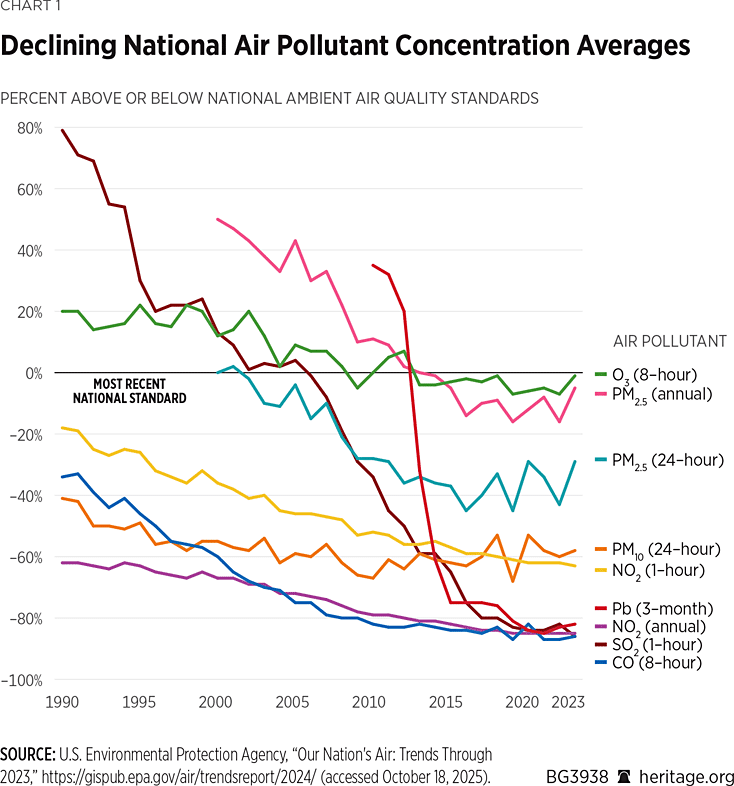
Climate Livability. It is true that 2024 was the warmest year on record (~1.47°C above the 1850–1900 baseline),REF but the premise that the world is becoming more dangerous for people is not supported by the data. The longer-run story for people is greater safety from climate-related hazards because development, early warning, and infrastructure dramatically reduce vulnerability.REF According to the International Disaster Database, climate-related deaths across the globe are on a steady downward trend and have fallen by more than 90 percent over the past century.REF In the U.S., strong tornadoes have fallen ~50% since the 1950s, and (when adjusted for how much has been built) normalized tornado damage has decreased.REF Wildfire severity on federal lands shows no clear long-term upward trend in the century-scale record; recent spikes are dominated by (sometimes intentional) human ignition and exposure patterns, not by a new climate regime.REF
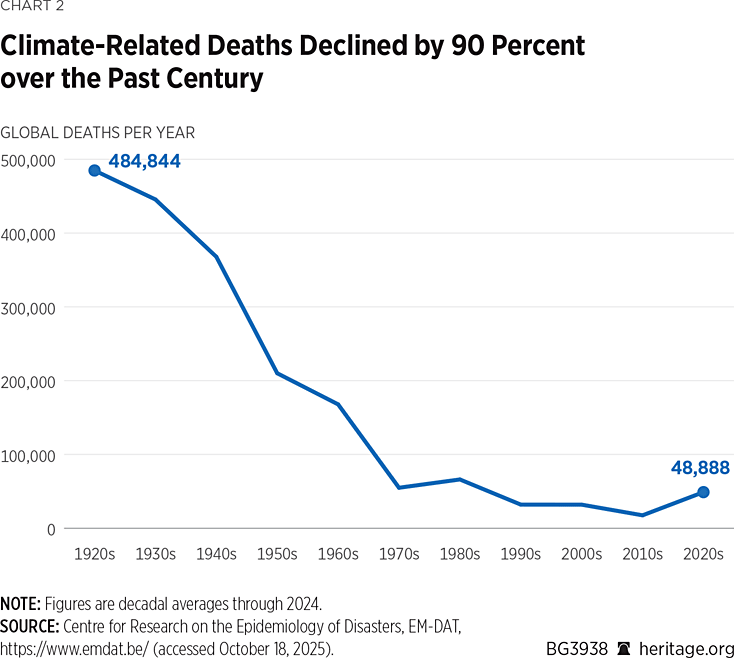
This immense climate progress—the result of human productivity and economic progress—is even more impressive when considering today’s larger population. Measured per million people, climate-related deaths fell from 255.3 in 1920 to 1.9 in 2020, a decline of 99.25 percent.REF The climate’s effect on human survivability is improving along with economic expansion and population growth.
Data on climate livability challenge the dominant narrative that the climate is becoming increasingly dangerous and suggest an alternative policy response. Rather than constraining economic development in an effort to maintain pre-industrial temperatures, a pro-human approach would be to promote economic growth as a way to further the enhancement of climate livability.
Resource Availability. Some say that humans are burning through a finite pool of resources that they are bound to exhaust, but one simple question upends that worldview: Are there more resources now than there were 100 or 200 years ago? The answer is clearly “yes,” and if there are more resources now, there must be more resources than meet the eye. The world has learned two things:
- America can create new resources. Although the raw materials on Planet Earth are finite, our ability to turn those raw materials into valuable resources is limited only by our ability to innovate.
- America can optimize existing resources. As people use more of them, Americans can economically substitute for the most efficient resource and shift away from scarce resources.
Regarding the creation of new resources, think about whether one of the most valuable traded commodities in the world today—crude oil—was really a resource before people knew what to do with it. Although more unrefined crude oil existed on Earth 200 years ago, it was not readily available as a usable source of energy to power machinery or sustain the modern economy.REF Resources are not finite, because the essence of a resource is the application of new technical know-how to existing raw materials. In that sense, the planet’s resources are constrained not by physical scarcity but by the boundaries of human ingenuity.
The brief history of natural gas from shale rock illustrates the link between technological change and the economic definition of a resource. Hydrocarbon molecules, such as methane (CH₄), exist within rock formations located more than a mile beneath the Earth’s surface, yet their classification as a resource depends on whether they can be accessed and converted into useful energy. Earlier this century, these molecules were not considered a resource because their extraction was technologically infeasible. With the advent of directional drilling and hydraulic fracturing, these formations became economically viable, enabling the energy contained in shale gas to power households and industries. In America, the production of shale gas continues its ascent from near-zero to almost 80 percentREF of our total production of dry natural gas.REF
Today, conventional fuels—oil, coal, and natural gas—are the lifeblood of the global economy. Without them, there would be no modern shipping, transportation, electricity, or the thousands of different products in which they are a key ingredient. But hydrocarbons are more than a physical component of nearly every modern product; they are also instrumental in each product’s supply chain and logistical history. Everything anyone purchases was once on a cargo vessel, airplane, train, truck, or all of them at different stages in its journey to the buyer.
We have not exhausted energy resources. People keep producing and using more resources (and new kinds, including renewables) all the time.
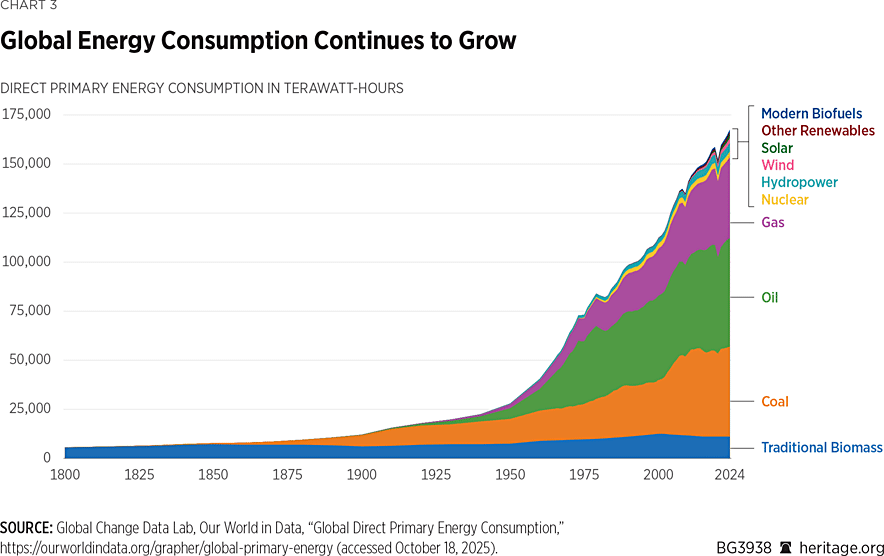
To the neo-Malthusian environmentalist, none of this observable good news or optimism about the future is even possible. Data reveal that the predictions of neo-Malthusianism do not hold. This is welcome news.
Climate Is Better, but Attitudes About Climate Are Worse
Dr. Matthew Wielicki, a geological sciences professor at the University of Alabama, told Fox News, “I’ve had multiple students come to me and tell me they no longer plan on having a family because they don’t think raising children in this world would be a smart idea because the planet is going to end.”REF
A 2021 survey by the Pew Research Center supports the observation that younger adults are harder hit by climate anxiety. In Pew’s poll, 71 percent of people 18–29 years old answered that they were “very/somewhat concerned that global climate change will harm them personally at some point in their lifetime.” For respondents who were 65 or older, the share who were “very/somewhat concerned” was 52 percent.REF This polling indicates that, although concern over the climate is widespread, it is more acute in younger people.
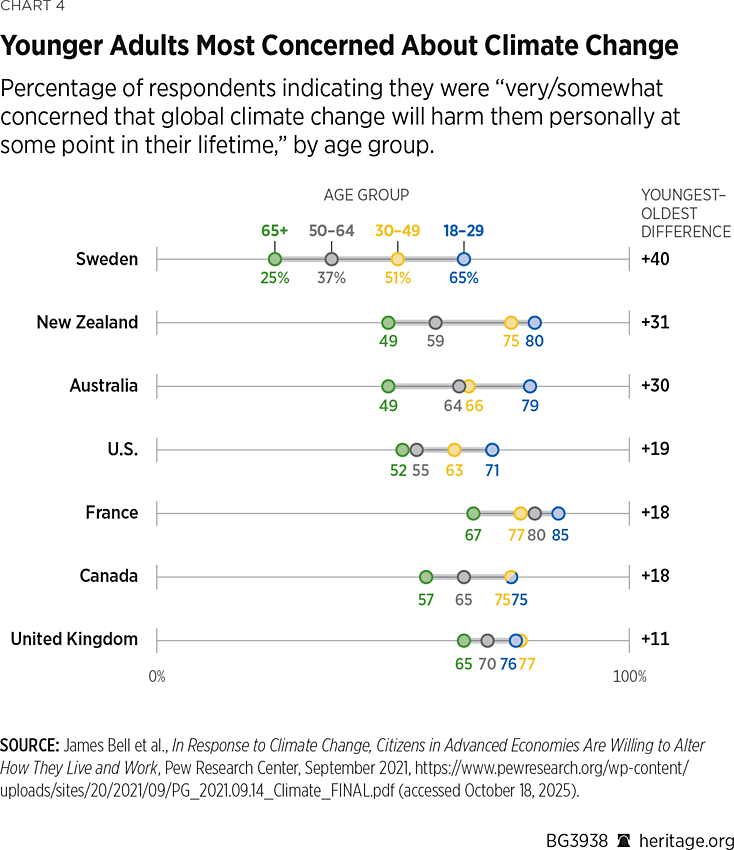
The Pew polling also showed that American women were more concerned than American men by a 12-point margin. For women, 66 percent responded that they were “very/somewhat concerned that global climate change will harm them personally at some point in their lifetime,” compared to 54 percent of men.REF
Gallup also conducts polls on attitudes about the environment. According to Gallup, as of March 2025, 54 percent of respondents believed protection of the environment should come before economic growth, compared to 38 percent in favor of the inverse.REF The question itself ought to demonstrate the scale to which the fundamental point of this paper is misunderstood. Respondents were asked, “With which one of these statements do you most agree” and given two choices: “protection of the environment should be given priority, even at the risk of curbing economic growth (or) economic growth should be given priority, even if the environment suffers to some extent.”REF
The trouble with this question is that it places economic growth and protection of the environment at odds with each other when, in truth, they are complements. Furthermore, 62 percent of respondents answered “getting worse” to the question: “Right now, do you think the quality of the environment in the country as a whole is getting better or getting worse?”REF As shown below, over the 25 years of this poll, “getting worse” always received a higher response than “getting better.”
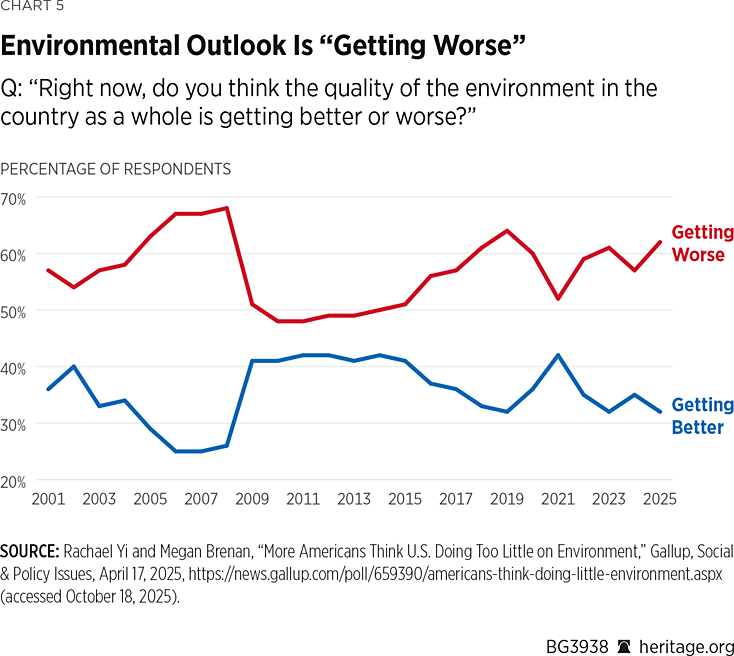
Although pessimism about the environment is well established, a new type of negativity is emerging: one that is focused on global climate change. A comment in the journal Nature Climate Change highlights the effects of the climate anxiety phenomenon:
Media messaging of a looming climate crisis can fuel climate anxiety. For example, due in particular to traditional and social media reframing, the aspirational 1.5 °C global warming threshold—a goal that physical, socioeconomic and infrastructure constraints have now rendered unlikely—is transmuting from a driver of change to an instigator of anxiety.REF
This type of climate crisis messaging may trigger people’s primal survival instincts.REF Those who truly believe the planet is dying are living in a perpetual state of fear and anxiety as their perceived impending downfall approaches. The problem of existential climate concerns and their effect on mental health grew large enough to warrant a study by the National Institutes of Health (NIH). The researchers concluded that “[f]or some individuals, the negative emotions caused by abstract awareness and acknowledgement of the ongoing climate change, even in those who are well insulated from any directly observable effects, can be intense enough to contribute to mental illness.”REF
This should not be taken lightly. The NIH has established that the current climate narrative is damaging people’s mental health—even the mental health of some who do not observe or experience any actual negative climate effects. This should give pause to those who are actively participating in the current climate discussion so that they can reassess (1) the facts that form the basis of the objective reality in which we live and (2) the significant impact that the doomsday climate narrative is having on the minds of people around the world. A bleak worldview does not encourage growth, development, and work but rather promotes despondency, helplessness, complacency, dependence, and dread. In the most extreme and tragic cases, mental illness exacerbated by climate anxiety has even led to suicide.REF
Are Negative Views on the Environment Reducing Birth Rates?
Climate alarmism, exacerbated by politicians and environmental advocates, has clearly resulted in serious cultural impacts, but is it also to blame for reduced birth rates? America currently ranks 145th globally in terms of births per person.REF and U.S. fertility hit a new low in 2024 and remains subdued in 2025.REF According to data published by the Centers for Disease Control and Prevention, annual birth rates in the U.S. have fallen steadily from 24.1 per 1,000 population in 1950 to 11.4 per 1,000 population in 2019.REF Additionally, the fertility rate per woman in the U.S. has plummeted well below replacement levels of 2.1. The CDC reports that the total fertility rate fell from 2.08 in 1990 to about 1.62 in 2023 with the general fertility rate down 23 percent over the same period.REF The big shift is timing: Women under 30 years of age went from nearly seven in 10 births (69.8 percent) in 1990 to fewer than half (48.6 percent) in 2023, while a majority of U.S. births are now to women 30 or more years old.REF The CDC’s analysis makes clear that some delayed births are made up later, but some are never realized, which is why overall fertility remains well below replacement.
Correlation does not mean causation. Birth rates seem to be negatively correlated with such circumstances as advanced economic development and education.REF However, emerging anecdotal evidence suggests that reduced birth rates could be partially explained by growing concerns over the environment generally and climate change specifically. If concerns over the state of the environment are contributing to reduced birth rates, it is worth correcting the record and establishing a factually sound basis for family decisions.
Many cite cost of living, housing, work–family trade-offs, partnership, and climate concerns as reasons not to have children or more children.REF Nationally representative data confirm that environmental concerns now register for a meaningful share of would-be parents. Among U.S. adults under 50 who say they are unlikely ever to have children, about one in four (26 percent) cite concerns about the environment, including climate change, as a major reason.REF
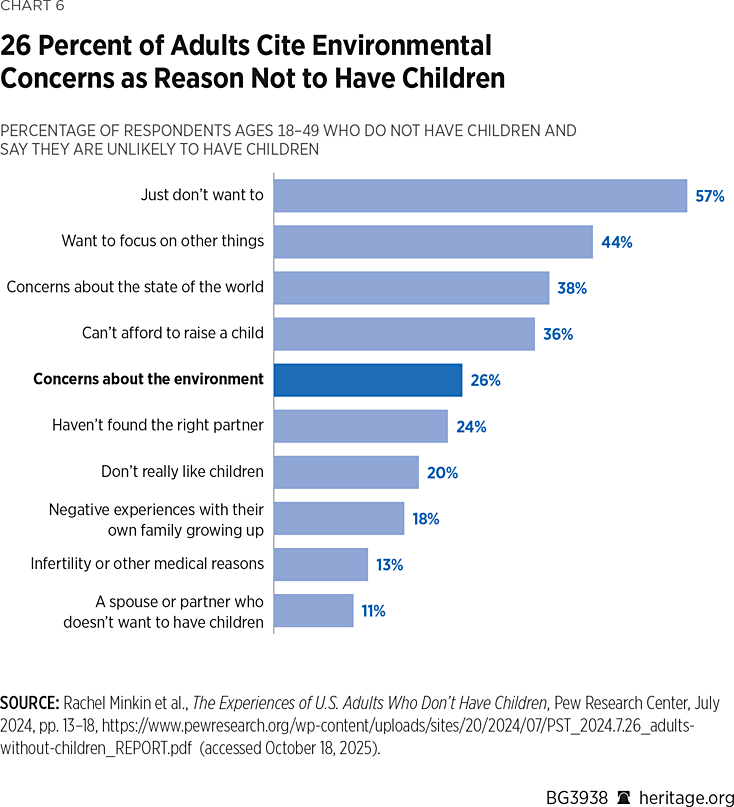
In an NIH study focusing on Polish residents, the authors confirmed the presence of “ecological anti-natalism,” which they say “focuses on the irreversible harm that people cause to the environment and…leads to postulates such as: reducing the number of people would slow down the changes, and bringing new lives into the world, which is endangered by environmental catastrophe, is highly immoral.”REF In other words, instead of developing climate solutions that achieve the complementary aims of human well-being and good environmental stewardship, the above view discusses the opposite, woefully attempting to misguide people into thinking that their well-being today and having children tomorrow are immoral.
As climate alarmism has become more mainstream, the world has seen the rise of movements of an increasingly pessimistic, nihilistic, destructive, and fundamentally anti-human nature, such as the Birthstrikers,REF anti-natalists,REF and Voluntary Human Extinction Movement.REF Members of these groups believe that the Earth is on the verge of climate collapse because of human impacts and that humanity has about 10 years (if that many) either to reverse our perceived damage to the climate or to fall victim to irreversible global climate devastation.
With such a grim view of the future—which is not only incorrect in assigning immorality, but immoral itself—and because of the extremely limited timetable these advocates have set for themselves, some of their proposed solutions to “save the planet” are horrific and would end human life as we know it.
Will the Environment Always Become Safer and Cleaner?
Contrary to the views held by neo-Malthusians, Birthstrikers, and anti-natalists, the evidence shows that human advancement and growth are not antithetical to maintaining a healthy and vibrant environment.REF Rather, as a nation’s living standards improve and individuals become wealthier in terms of the real goods and services that are available to them, they begin to care more about being good stewards of the land they inhabit. The environment will continue to become safer and cleaner as long as people have a pro-human vision for the future (i.e., a future in which population growth and economic expansion are embraced).
When people are living in abject poverty, their sole purpose is the struggle for basic survival. To see fellow humans living in such dire circumstances naturally makes the observer wonder why such suffering exists. On the one hand (the negative), such an image is discouraging and begs the question of whether it is “worth” inserting another life into such circumstances. On the other hand (the positive), the observer recognizes the same dreadful state, but instead of being complacent and assuming that nothing can be done, he strives upward to find a way to alleviate the suffering and improve the material condition of his fellow man. An advocate of depopulation will likely hold that such people should be phased out over time and that a smaller population composed implicitly (and sometimes explicitly) of the “right” people can live better than a larger population can. In contrast, the pro-human advocate believes in the more fulfilling task of not only raising the destitute out of absolute poverty, but also giving them the opportunity to truly flourish and have children of their own.
When people no longer worry about how to get their next meal, they reach a position where they can begin thinking medium to long term. In other words, when people’s basic survival needs are met, their attention can be shifted elsewhere, including toward environmental protection. Thus, through economic development, modernization, and the improvement of living standards, more people can start to make long-term plans. For example, instead of worrying about finding enough wood to heat their home, parents can think about building a future for their children that includes higher education and cleaner air.
Readers may wonder what justifies such optimism: Again, it is supported by the data. A well-known case of optimism winning the day is the famous bet between Julian Simon and Paul Ehrlich on whether resource prices would increase or decrease over the course of the following decade.REF When prices fell, much to Ehrlich’s chagrin, the case for human innovation and problem-solving won and earned much credibility. The bet was a microcosm of the broader evidence for Simon’s thesis: Human ingenuity expands effective resources and advances economic progress even on a planet with finite raw materials.
Conclusion
Concerns about the supposedly worsening environment are no reason not to have children. The world is not on the brink of climate collapse, the environment is getting cleaner, and people have every reason and incentive to have all the children they want to have. People should not let misguided pessimism about the state of the environment keep them from raising a family and enjoying the profoundly rewarding personal experiences and positive economic effects that this experience yields. The evidence demonstrates that the hopelessness of climate alarmism is misplaced, and children will do more to help the environment and solve climate problems than they will to exacerbate them.
What depopulators either do not understand or refuse to accept is that quality of life and environmental protection are complementary: We can have our cake and eat it too. Population growth and improvements in living standards support environmental protection because individuals who can anticipate the long-term future for themselves and their families are more likely to act sustainably. When enduring absolute poverty, people focus only on the fight for their immediate survival. However, when an economy reaches a level where people’s basic needs (ample food, clothing, shelter, and plentiful energy) are met, the need to address the present diminishes, allowing space for families to look toward a future that includes a clean, enjoyable, and sustainable environment.
Many have found that there is nothing more fulfilling than raising children. To borrow from Nietzsche, a person’s children are the driving “why” that allows them to survive any “how.”REF Data presented in this paper show that climate fears are tragically overblown and that a growth mindset combined with more people brings us more prosperity and a better, safer, and cleaner environment.
Diana Furchtgott-Roth is Director of the Center for Energy, Climate, and Environment and the Herbert and Joyce Morgan Fellow at The Heritage Foundation. This report includes contributions from Alexander Gage, Travis Fisher, and Krishna Mehta.













